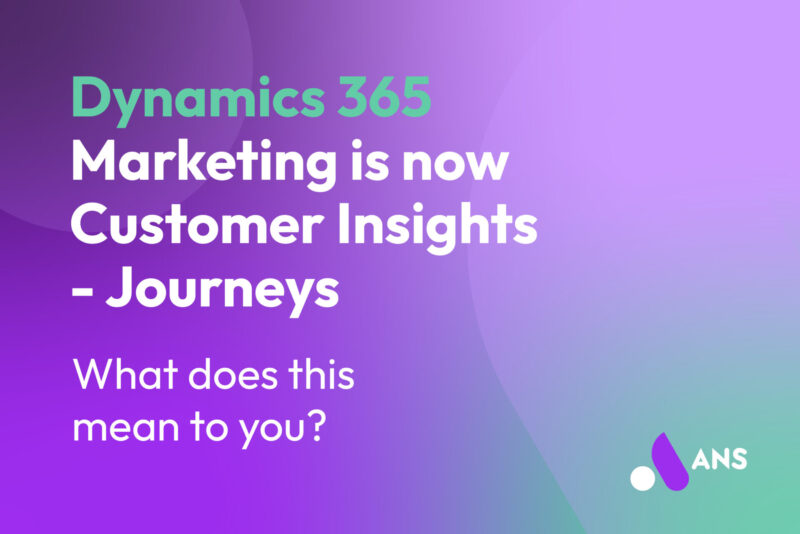At the Microsoft Inspire conference on July 18th, it was announced that the much-loved Microsoft Dynamics 365 Marketing brand will be combined with the lesser-known Dynamics 365 Customer Insights. From 1st September, these two products will be merged into a single brand and license, encompassing all the great features of both. The two new products will be:
- Microsoft Dynamics Customer Insights (CI) – Journeys (a.k.a Marketing)
- Microsoft Dynamics Customer Insights (CI) – Data (a.k.a Customer Insights)
In this blog post, Dan Barber, ANS head of business applications, breaks down what this announcement means to you.
No more outbound marketing!
This is not only a merging of two products, but there’ll also be an emphasis on real-time marketing (RTM) functionality only. It means that outbound marketing (OBM) will not be available to new users from August 2023.
Existing customers can add OBM to their application through a self-serve portal to continue using this module, and Microsoft hasn’t confirmed if/when OBM will be deprecated. However, Microsoft has made it clear that no new features will be developed for OBM from now on, and their investments will focus on the two CI products mentioned above.
Whilst at first glance, I was a little shocked and confused. Yet, the more I thought about it, the more I understood the intent behind the decision.
Although Dynamics 365 Marketing is an established brand, marketing strategies have evolved. This rebranding is an attempt to capture that evolution.
The previous Dynamics Marketing focussing on outbound marketing, caters to more traditional aspects of marketing by providing one-size-fits-all communications. However, today’s marketing strategies are shifting towards personalised, instant interactions in the moments that matter.
This is why the move made more sense to me, and hopefully, it will to you by the end of the article. I might still refer to the application as ‘Marketing’; however, the brain re-training has already begun.
Why does this make more sense?
Since the introduction of real-time marketing in 2021, there has been a shift in the way marketers deliver great customer service through targeted messaging. This move has prompted them to design our interactions based on triggers, ensuring messages reach users at the right time in their journey.
Instead of delivering messages on a pre-determined schedule based on their profiles (although there are still clear use cases for this), marketers started considering a user’s real-time actions and preferences, making it more relevant to suppliers and consumers.
Meanwhile, Customer Insights has been crafting a core following, allowing organisations to unify disparate data sources into a single Customer Data Platform. This provides a holistic, unified customer view with metrics and insights that can be used to target messaging and drive meaningful actions.
Bringing these two powerful functions under one umbrella will seamlessly allow you to understand your client profile and interact in a highly personalised way through a single solution.
What's changing?
Let’s look at what will and won’t change following this rebrand:
- Under the new single license, you’ll now have access to all the functionality of both Marketing & Customer Insights.
- If you decide to start transitioning from OBM to RTM, you can start benefitting from the following features:
- Trigger-based journeys
- Copilot generative AI capabilities for creating segments using natural language
- Target leads, contacts and Customer Insights profiles
- Copilot generative AI capabilities for writing emails (Content ideas, image suggestions, writing style suggestions and more)
- Enhanced web forms
- SMS and push notification channels
- AI-Powered channel optimisation
- Conditional content for personalisation
- Support individual business units allowing unique brands and content
- Seamless lead handoff to sales teams
- OBM segments can still be used in RTM journeys.
- Emails and content blocks will utilise the same interface; however, existing OBM emails will need to be re-created when you want to transition your marketing activities to RTM. You don’t have to create this from scratch, as there are features to assist with this move. For more information on this please visit Dynamics 365 Customer Insights
questionnaire. - By default, Dynamics 365 outbound marketing ensures each message is sent only once to each unique email address. This will not be applicable to real-time marketing. Please note that the frequency cap feature will still give you control over the number of messages sent to recipients in a given period.
- Asset libraries are shared between OBM and RTM, so there is no need for a change here.
- Text messages will not be migrated and must be recreated in RTM.
- Marketing Forms will have to be recreated, but the good news is that RTM forms combine both pages and forms, making the process fast and efficient.
- Consent data will have to be migrated, but this can easily be done through an out-of-the-box import process.
- Event management in RTM hasn’t reached the same level of maturity in OBM yet, so check out this list to judge the appropriate time to transition here.
Licensing.
Last but not least, here are some key facts to consider about licensing:
- Going forward, there will be only one license that includes the following:
- 10,000 People Interacted – Any Dataverse entity that is interacted with (outbound or inbound) via a marketing tool such as a form, email, SMS, push, ACS, 3rd party systems. This will govern CI – Journeys
- 100,000 People Unified – a unique and recognisable individual created through a collection of defined data sources from several systems
- Additional units of both can be purchased, allowing you to reach 100 million individuals and 300 million interactions per month
- The pricing for the new product is $1,700 for new customers and $1,000 for existing customers. However, please note that this is subject to change when it’s officially released on the 1st of September. So check this page out to compare and confirm pricing closer to the release date.
What do I need to do?
Check out these resources to learn more about RTM and Customer Insights. Start thinking about your transition to RTM with these simple steps:
- Phasing the transition
- Identify simple customer journeys
- Train internal systems teams
- Ensure there is a feedback loop to enhance adoption and value
- Identify your trigger conditions for these “moments that matter”
- Start looking to rebuild OBM segments, emails and content blocks
Remember, transitioning to RTM is a journey in itself. We are here to assist you at every step, but the key is to start planning now.
Hope you found this information useful. Please contact us if you have any questions about the transition to real-time marketing, deployment or need additional training on Dynamics 365 Customer Insights or Marketing.





